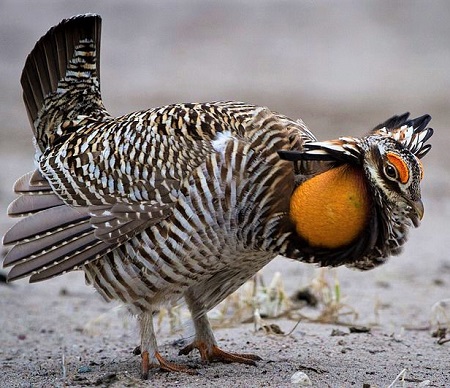Greater Prairie-Chicken
The Greater Prairie-Chicken or the Pinnated Grouse is a rare North American species of Grouse. It’s a stocky brown, strongly barred bird with paler colored stripes. The Greater Prairie-Chicken is easily recognized by the male’s distinctive and impressive appearance during courtship display.
The male Greater Prairie-Chicken has orange comb-like feathers over his eyes and dark, elongated head feathers that can be raised or lain along the neck. He also possesses circular, orange neck sacs which can be inflated while displaying. The female Greater Prairie-Chicken has shorter head feathers and lacks the male’s yellowish-orange comb and orange neck sacs. Both sexes can also be distinguished by their short tail, being dark-brown in males, and barred-brown and tan in females. The Greater Prairie-Chicken is similar to its relative the Lesser Prairie-Chicken, but the latter species is smaller and paler in color.
The breeding season of the Greater Prairie-Chicken begins in early spring and extends until June. Females usually build their nests in tall grass, and lay around 12 eggs per clutch. They incubate the eggs for approximately 26 days. Greater Prairie-chicks are quite mobile at hatching and can fly short distances by two weeks. But they remain with the hen for eight to ten weeks. There are currently two subspecies for the Greater Prairie-Chicken found in scattered areas of southern Canada and the mid-western USA.
| Place of origin | The USA and Canada |
| Use | Preservation |
| Weight | Male: mean 972 g female: mean 813 g |
| Egg color | Olive to pale buff, speckled with dark brown |



